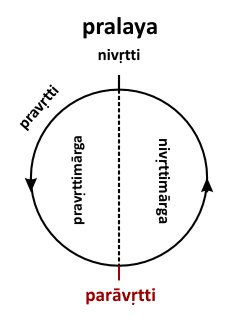The Yogācāra system is presenting us with 8 vijñāna’s, evolving from one basic form of consciousness, which is the ālayavijñāna. A common translation of vijñāna in the context of Yogācāra Buddhism would be “consciousness”, however, the concept of vijñāna as part of the epistemology of Yogācāra Buddhism, is a specific type of consciousness, a faculty of the mind, which is the counterpart of a specific source of knowledge. The basic principles of this epistemology are comparable to the Saṃkhya philosophy, where every organ of perception has its counterpart in a specific faculty of the mind.
In Daisetz Teitarō Suzuki’s Studies in the Lankavatarasutra (p. 186), three modes or aspects (lakṣaṇa) of vijñāna are presented:
In the state of pralaya, which we could think of as the state before the beginning of the evolution of a human entity, the vijñāna’s are absorbed in ālayavijñāna, which is then in its jāti state, its “original nature”. (cp. Suzuki, The Laṅkāvatāra Sūtra, p. xvii-xviii) When the human entity starts to evolve, the vijñānas arise from ālayavijñāna, which is then at the same time in another state, called pravṛtti, i.e. evolving. In yoga philosophy, the terms pravṛtti and nirvṛtti (or nivṛtti) are connected with evolution and involution, pravṛttimārga and nirvṛttimārga being the outward and inward arc of an evolutionary cycle. They indicate cyclic development, first directed outward, where the entity expresses itself through form, and then inward, where the entity gradually becomes a master of its form, and eventually becomes independent of it. The cycle has a turning point in the middle, where development starts turning inward, which in the Laṅkāvatāra is called parāvṛtti, which is litterally “turning back”. (cp. The Laṅkāvatāra Sūtra, p. xvii) At this point of revolution, there is an opportunity for the deep mystical realisation of the relation of the entity with its form. This realisation takes place, according to the Laṅkāvatāra, “in the Ālaya, which is the basis of all things”, as Suzuki formulates it. (Studies p. 184)

In Suzuki’s Studies (p. 186-187) we find:
To make sure that we understand correctly, the Laṅkāvatāra firmly underlines its standpoint concerning ālaya on p. 34-35:
If we translate the first sentence of this fragment more in the light of our understanding of the cyclic process, the result could be something like:
[…] sa ca na bhavati svajātilakṣaṇanirodhaḥ | tasmānmahāmate na svajātilakṣaṇanirodho vijñānānāṃ kiṃ tu karmalakṣaṇanirodhaḥ |
The term used here for self-origination is svajāti, own-birth or self-birth, not jāti, birth, indicating the idea of auto-creation and auto-re-creation, showing a quite profound universal philosophical concept. Interestingly, that which is said to “cease” is the karman aspect and not the pravṛtti aspect. In the Book of Dzyan it is stated that evolution never ceases, and that pralaya and the birth of the new universe are just phases of the ever moving evolutionary process. (Note, that in this case the term pravṛtti would have a slightly different meaning than when it is seen as the complement of nivṛtti.)
In SD I, 49 we see that HPB recognized different aspects to the term ālaya:
What are the doctrines taught on this subject by the Esoteric “Buddhists”? With them “Alaya” has a double and even a triple meaning.
In SD I, 48, at least two aspects (our jāti and pravṛtti) are spoken of:
Again in SD I, 48, following Emil Schlagintweit (Buddhism in Tibet, p. 39), we have the jāti and pravṛtti aspects (or perhaps even the jāti and karman aspects):
These paradoxes show ālaya remaining in its original nature, and at the same time evolving. This principle explains the phrase in the Book of Dzyan, why in the cosmic night “the alaya of the universe was in paramartha”, in SD I, 47 (stanza 1 śloka 9):
In HPB’s commentary between brackets, we see that she defines ālaya as the “Soul”, “the basis of all” (Tibetan: kun gzhi), which she identifies with the Anima Mundi. This term refers to Hellenistic philosophy, and connects our investigation into ālaya directly to the third “fundamental proposition” of The Secret Doctrine. Again in SD I, 48, we find:
The third fundamental proposition, in the Proem, SD I, 17 under (c), states:
Here we also have the other two aspects, pravṛtti and karman, as Cyclic and Karmic Law. In the case of the universal over-soul, being “an aspect” of the unknown root, we can ask ourselves which aspect of the unknown root (SPACE) it is. Is it a manifested or unmanifested, or even a manifesting or unmanifesting aspect of the Logos? This is not sufficiently clear from this fragment. In the Theosophical Glossary under Alaya, we find the following definition:
Alaya (Sk.) The Universal Soul (See Secret Doctrine Vol. I. pp. 47 et seq.). The name belongs to the Tibetan system of the contemplative Mahâyâna School. Identical with Âkâsa in its mystic sense, and with Mulâprâkriti, in its essence, as it is the basis or root of all things.
Here we see that ālaya is identified with the First Logos (mūlaprakṛti) in its essence, “as it is the basis or root of all things” (Tibetan: kun gzhi).
In CW XII, 635 (ES Instruction III), we read:
and in CW XII, 607:
|
Aspect of ālaya |
Corresponds to |
Cosmic |
|
|
1. jāti |
remaining in its original nature |
First Logos |
|
|
2. pravṛtti |
evolving |
Second Logos |
[Emerson’s Over-Soul, Anima Mundi] Mahat, [called Maha-Buddhi], Universal Mind, [Universal Soul] |
|
3. karman |
producing effects |
Third Logos |
|
Corrected according to The Universal Over-Soul